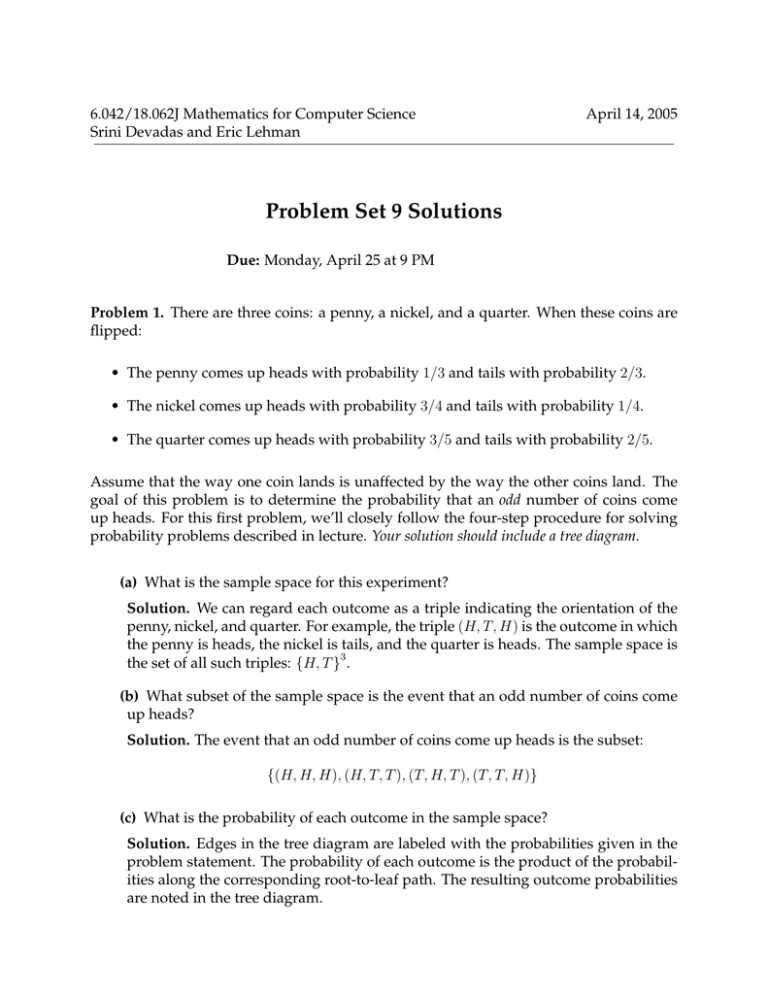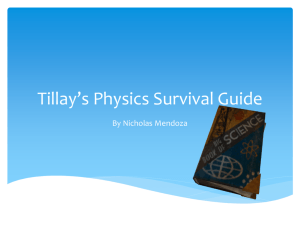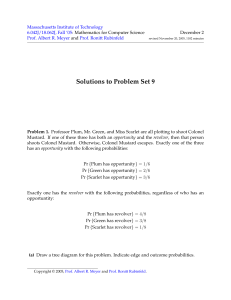Problem
advertisement

6.042/18.062J Mathematics for Computer Science
Srini Devadas and Eric Lehman
April 14, 2005
Problem Set 9 Solutions
Due: Monday, April 25 at 9 PM
Problem 1. There are three coins: a penny, a nickel, and a quarter. When these coins are
flipped:
• The penny comes up heads with probability 1/3 and tails with probability 2/3.
• The nickel comes up heads with probability 3/4 and tails with probability 1/4.
• The quarter comes up heads with probability 3/5 and tails with probability 2/5.
Assume that the way one coin lands is unaffected by the way the other coins land. The
goal of this problem is to determine the probability that an odd number of coins come
up heads. For this first problem, we’ll closely follow the four­step procedure for solving
probability problems described in lecture. Your solution should include a tree diagram.
(a) What is the sample space for this experiment?
Solution. We can regard each outcome as a triple indicating the orientation of the
penny, nickel, and quarter. For example, the triple (H, T, H) is the outcome in which
the penny is heads, the nickel is tails, and the quarter is heads. The sample space is
the set of all such triples: {H, T }3 .
(b) What subset of the sample space is the event that an odd number of coins come
up heads?
Solution. The event that an odd number of coins come up heads is the subset:
{(H, H, H), (H, T, T ), (T, H, T ), (T, T, H)}
(c) What is the probability of each outcome in the sample space?
Solution. Edges in the tree diagram are labeled with the probabilities given in the
problem statement. The probability of each outcome is the product of the probabil­
ities along the corresponding root­to­leaf path. The resulting outcome probabilities
are noted in the tree diagram.
2
Problem Set 9
H
3/5 H XXXX
3/4 2/5 XX
T
HH
H
3/5 H
1/4 HH
XX
T H
XX
2/5 XX
H
1/3
T
@
@ 2/3
@
@
T @
×
6/60
3/60
×
H
3/5 X
H XXX
3/4 2/5 XX
T
@
penny HH
H
3/5 H
1/4 HH
XXX
T H
X
2/5 XX
nickel
T
quarter
9/60
2/60
18/60
×
12/60
×
6/60
4/60
odd?
prob.
(d) What is the probability that an odd number of coins come up heads?
Solution. The probability of an event is the sum of the probabilities of the outcomes
in that event. In this case:
Pr (odd number of heads)
= Pr ({(H, H, H), (H, T, T ), (T, H, T ), (T, T, H)})
= Pr ((H, H, H)) + Pr ((H, T, T )) + Pr ((T, H, T )) + Pr ((T, T, H))
9
2
12
6
=
+
+
+
60 60 60 60
29
=
60
Problem 2. Professor Plum, Mr. Green, and Miss Scarlet are all plotting to shoot Colonel
Mustard. If one of these three has both an opportunity and the revolver, then that person
shoots Colonel Mustard. Otherwise, Colonel Mustard escapes. Exactly one of the three
has an opportunity with the following probabilities:
Pr (Plum has opportunity) = 1/6
Pr (Green has opportunity) = 2/6
Pr (Scarlet has opportunity) = 3/6
Exactly one has the revolver with the following probabilities, regardless of who has an
opportuntity:
Pr (Plum has revolver) = 4/8
Pr (Green has revolver) = 3/8
Pr (Scarlet has revolver) = 1/8
Problem Set 9
3
(a) Draw a tree diagram for this problem. Indicate edge and outcome probabilities.
Solution.
P
4/8 G
H
HH 3/8
H
1/8 HH
P
S
1/6
P
4/8 G
G
H
J 2/6
H
HH 3/8
J
1/8 HH
J
S
J 3/6
J
P
SJJ
4/8 J
G
J
HH
opportunity HH 3/8
1/8 HH
4/48
3/48
1/48
8/48
6/48
2/48
12/48
S
revolver
9/48
3/48
prob.
(b) What is the probability that Colonel Mustard is shot?
Solution. Denote each outcome with a pair indicating who has the opportunity
and who has the revolver. In this notation, the event that Colonel Mustard is shot
consists of all outcomes where a single person has both:
{(P, P ), (G, G), (S, S)}
n The probability of this event is the sum of the outcome probabilities:
Pr ({(P, P ), (G, G), (S, S)})= Pr ((P, P )) + Pr ((G, G)) + Pr ((S, S))
= 4/48 + 6/48 + 3/48
= 13/48
(c) What is the probability that Colonel Mustard is shot, given that Miss Scarlet does
not have the revolver?
Solution. Let S be the event that Colonel Mustard is shot, and let N be the event
4
Problem Set 9
that Miss Scarlet does not have the revolver. The solution is:
Pr (S | N ) =
Pr (S ∩ N )
Pr (N )
Pr ((P, P ), (G, G))
Pr ((P, P ), (P, G), (G, P ), (G, G), (S, P ), (S, G))
4
6
+ 48
48
= 4
3
8
6
9
+ 48
+ 48
+ 48
+ 12
+ 48
48
48
5
=
21
=
(d) What is the probability that Mr. Green had an opportunity, given that Colonel
Mustard was shot?
Solution. Let G be the event that Mr. Green has an opportunity, and again let S be
the event that Colonel Mustard is shot. Then the solution is:
Pr (G ∩ S)
Pr (S)
Pr ((G, G))
=
Pr ((P, P ), (G, G), (S, S))
Pr (G | S) =
=
=
4
48
+
6
48
6
48
+
3
48
6
13
Problem 3. There are three prisoners in a maximum­security prison for fictional villains:
the Evil Wizard Voldemort, the Dark Lord Sauron, and Little Bunny Foo­Foo. The parole
board has declared that it will release two of the three, chosen uniformly at random, but
has not yet released their names. Naturally, Sauron figures that he will be released to his
home in Mordor, where the shadows lie, with probability 23 .
A guard offers to tell Sauron the name of one of the other prisoners who will be re­
leased (either Voldemort or Foo­Foo). However, Sauron declines this offer. He reasons
that if the guard says, for example, “Little Bunny Foo­Foo will be released”, then his own
probability of release will drop to 21 . This is because he will then know that either he or
Voldemort will also be released, and these two events are equally likely.
Using a tree diagram and the four­step method, either prove that the Dark Lord Sauron
has reasoned correctly or prove that he is wrong. Assume that if the guard has a choice
of naming either Voldemort or Foo­Foo (because both are to be released), then he names
one of the two uniformly at random.
Solution. Sauron has reasoned incorrectly. In order to understand his error, let’s be­
gin by working out the sample space, noting events of interest, and computing outcome
probabilities:
Problem Set 9
5
F
1
1/3
F, S
@
@
F 1/2
1/3
×
×
1/6
×
×
×
F, V HH
1/3
H 1/2
V, S@
@ 1/3
@
@
released
HH
V
H
1
×
1/6
×
1/3
V
guard says
prob.
guard says Foo-foo
”Foo-foo” released
Sauron
released
Define the events S, F , and “F ” as follows:
“F ” = Guard says Foo-Foo is released
F = Foo-Foo is released
S = Sauron is released
The outcomes in each of these events are noted in the tree diagram.
Sauron’s error is in failing to realize that the event F (Foo-foo will be released) is different from the event “F ” (the guard says Foo-foo will be released). In particular, the
probability that Sauron is released, given that Foo-foo is released, is indeed 1/2:
Pr (S | F ) =
=
=
Pr (S ∩ F )
Pr (F )
1
3
1
3
1
6
+ +
1
6
1
2
But the probability that Sauron is released given that the guard merely says so is still 2/3:
Pr (S | “F ”) =
=
=
Pr (S ∩ “F ”)
Pr (“F ”)
1
3
1
3
+
1
6
2
3
So Sauron’s probability of release is actually unchanged by the guard’s statement.
Problem 4. You shuffle a deck of cards and deal your friend a 5-card hand.
6
Problem Set 9
(a) Suppose your friend says, “I have the ace of spades.” What is the probablity that
she has another ace?
Solution. The sample space for this experient is the set of all 5­card
All
� hands.
�
.
Let
S
be
outcomes are equally likely, so the probability of each outcome is 1/ 52
5
the event that your friend has the ace of spades, and let A be the event that your
friend has another ace. Our objective is to compute:
Pr (A | S) =
Pr (A ∩ S)
Pr (S)
The number of hands containing the ace of spades is equal to the number of ways
to select 4 of the remaining 51 cards. Therefore:
�51�
4
�
Pr (S) =
�
52
5
The number of hands containing the ace of spades and at least one more ace is:
� �� � � �� � � �� �
3 48
3 48
3 48
|A ∩ S | =
+
+
1
3
2
2
3
1
Here
� the
� first term counts the number of hands
� � with one additional ace, since there
ways to choose the other cards. Sim­
are
31 ways to choose the extra ace and 48
3
ilarly, the second term counts hands with two additional aces, and the last term
counts hands with all three remaining aces. In probability terms, we have:
�3��48� �
3��48� �3��48�
+ 2 2 +
3 1
�52�
Pr (A ∩ S) = 1 3
5
Substituting these results into our original equation gives the solution:
�3��48� �
3��48� �3��48�
+ 2 2 +
3 1
�51�
= 0.2214 . . .
Pr (A | S)
= 1 3
4
(b) Suppose your friend says, “I have an ace.” What is the probability that she has
another ace?
Solution. The sample space and outcome probabilities are the same as before. Let
L be the event that your friend has at least one ace, and M be the event that your
friend has more than one ace. Our goal it to compute:
Pr (M | L) =
Pr (M ∩ L)
Pr (M )
=
Pr (L)
Pr (L)
The second equality holds because your friend surely at least one ace if she has more
than one; that is, M ⊆ L. The probability that your friend has at least one ace is:
�4��48� �4��48� �4��48� �4��48�
+
2 3 + 3 2 +
4 1
�52�
Pr (L) = 1 4
5
Problem Set 9
7
�
4�
The first term
counts
hands
with
a
single
ace,
since
there
are
ways to choose
1
�48
�
the ace and 4
ways to choose the remaining four cards. The remaining terms are
similar. The probability that your friend has more than one ace is:
�
4��48�
2
Pr (M ) =
3
+
�4��48�
�52
�2
3
+
�4��48�
4
1
5
Plugging these results into the original equation gives:
� �� � �4��48�
+ 43
48
+
Pr (M | L) = �4��
48� �4��48� 2
�4��48�4
1�4��48� = 0.12285 . . .
+ 2
3
+ 3
2 + 4
1
1
4
�4��48�
2
3
(c) Are your answers to (a) and (b) the same? Explain why.
Solution. The answers are different. There are four aces, so there are sixteen differ­
ent subsets of aces that your friend could have.
• If your friend says, “I have the ace of spades”, then eight of these subsets are
ruled out: those not containing the ace of spades.
• However, if your friend says, “I have an ace”, then only one subset is ruled out:
the subset containing no aces.
Thus, the probability that your friend has a second ace is different in these two cases,
because we are conditioning on two very different events!
Problem 5. (From an old final exam.) Finalphobia is a rare disease in which the victim has
the delusion that he or she is being subjected to an intense mathematical examination.
• A person selected uniformly at random has finalphobia with probability 1/100.
• A person with finalphobia has shaky hands with probability 9/10.
• A person without finalphobia has shaky hands with probability 1/20.
What is the probablility that a person selected uniformly at random has finalphobia, given
that he or she has shaky hands?
Solution. Let F be the event that the randomly­selected person has finalphobia, and
let S be the event that he or she has shaky hands. A tree diagram is worked out below:
8
Problem Set 9
has finalphobia?
yes
F
S
Probability
yes
X
X
9/1000
9/10
no
1/100
no
has shaky
hands?
99/100
1/10
X
yes
1/1000
X
99/2000
1/20
19/20
no
1801/2000
The probability that a person has finalphobia, given that he or she has shaky hands is:
Pr (F ∩ S)
Pr (S)
9/1000
=
9/1000 + 99/2000
18
=
18 + 99
18
=
117
Pr (F | S) =
Problem 6. Outside of their hum­drum duties as 6.042 TAs, Ishan is trying to learn to
levitate using only intense concentration and Grant is launching a “Wang 2008” presi­
dential campaign. Suppose that Ishan’s probability of levitating is 1/6, Grant’s chance of
becoming president is 1/4, and the success of one does not alter the other’s chances.
(a) If at least one of them succeeds, what is the probability that Ishan learns to levi­
tate?
Solution. Let L be the event that Ishan learns to levitate, and let P be the event that
Grant becomes president. We can work out the desired probability as follows:
Pr (L ∩ (L ∪ P ))
Pr (L ∪ P )
Pr (L)
�
�
=
1 − Pr L ∩ P
1/6
=
1 − (1 − 1/6)(1 − 1/4)
4
=
9
Pr (L | (L ∪ P )) =
Problem Set 9
9
The first step uses the definition of conditional probability. In the second step, we
rewrite both the top and bottom of the fraction using set identities. Then we substi­
tute in the given probability and simplify.
(b) If at most one of them succeeds, what is the probability that Grant becomes the
president of the United States?
Solution. Define events L and P as before.
�
�
� Pr P ∩ (L ∪ P )
�
�
Pr P | (L ∪ P ) =
Pr L ∪ P
�
�
Pr P ∩ L
=
1 − Pr (L ∩ P )
(1/4) · (5/6)
=
1 − (1/6) · (1/4)
5
=
23
�
(c) If exactly one of them succeeds, what is the probability that it is Ishan?
Solution.
�
�
Pr L | ((L ∩ P ) ∪ (L ∩ P )) =
�
�
Pr L ∩ P
�
�
Pr ((L ∩ P ) ∪ (L ∩ P ))
(1/6) · (3/4)
=
(1/6) · (3/4) + (5/6) · (1/4)
3
=
8
Problem 7. My computer came with the game Minesweeper. In this game, there is an 8 × 8
grid of squares. Ten randomly­selected squares contain mines, and all configurations of
mines are equally likely.
(a) What is the sample space for this game and what is the probability of each out­
come?
Solution. The sample space consists of all arrangements of 10 mines on the 8 × 8
board.
� � All such configurations have the same probability, which therefore must be
.
1/ 64
10
(b) After I made a few moves, the game board looked like this:
10
Problem Set 9
1
1
3
Now I know that the three numbered squares do not contain mines. Furthermore,
each number indicates how many squares adjacent to that number do contain mines.
(Two squares are adjacent if they share an edge or a corner.) Let E ⊆ S be the
event that the configuration of mines is consistent with this numbering. Describe all
outcomes in the event E.
Solution. Here is the board with some squares labeled for discussion:
a
b
c
d
e
a
1
1
3
e
a
b
c
d
e
We can divide all the outcomes in E into three groups based on the distribution of
mines among the squares labeled a, b, c, d, and e and the 49 blank squares:
a
b
1
0
0
0
1
0
# of mines
c d e other
0
0
1
1
0
0
2
3
2
6
# of configurations
�3��2��2��
2��3��49�
6
�3��2��2��
2��3��49�
7
�3��2��2��
2��3��49�
1
0
0
0
1
0
0
0
1
1
0
0
2
3
2
6
6
7
(c) On the next move, I must click an unnumbered square. If that square contains a
mine, I lose the game! The squares marked x and y in the diagram below look like
reasonable choices.
Problem Set 9
11
x XXX
XXX
XX
z
1
y
9
1
3
What is the probability that there is a mine at the square marked x?
Solution. If there is a mine at square x, then the state of all the other squares next to
numbers is complete determined and 6 of the other 49 squares are mined. Therefore,
the probability that x is mined is:
�49�
Pr (x mined ∩ E)
Pr (x mined | E) =
= 6 = 0.0175 . . .
Pr (E)
|E|
(d) What is the probability that there is a mine at the square marked y?
Solution. If there is a mine at square y, then two of the three squares marked e are
mined as well as 7 of the remaining 49 squares. Thus, the probability that there is a
mine at y is:
�3��49�
Pr (y mined ∩ E)
Pr (y mined | E) =
= 2 7 = 0.324 . . .
Pr (E)
|E|
Thus, a mine at y is 18+ times more likely than a mine x!
(You may leave your answers in symbolic form, but the numerical answers are surely
more interesting!)






